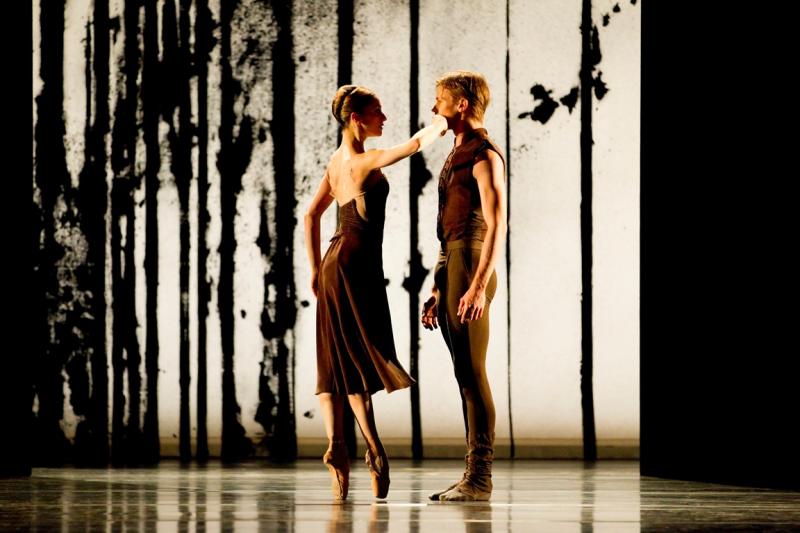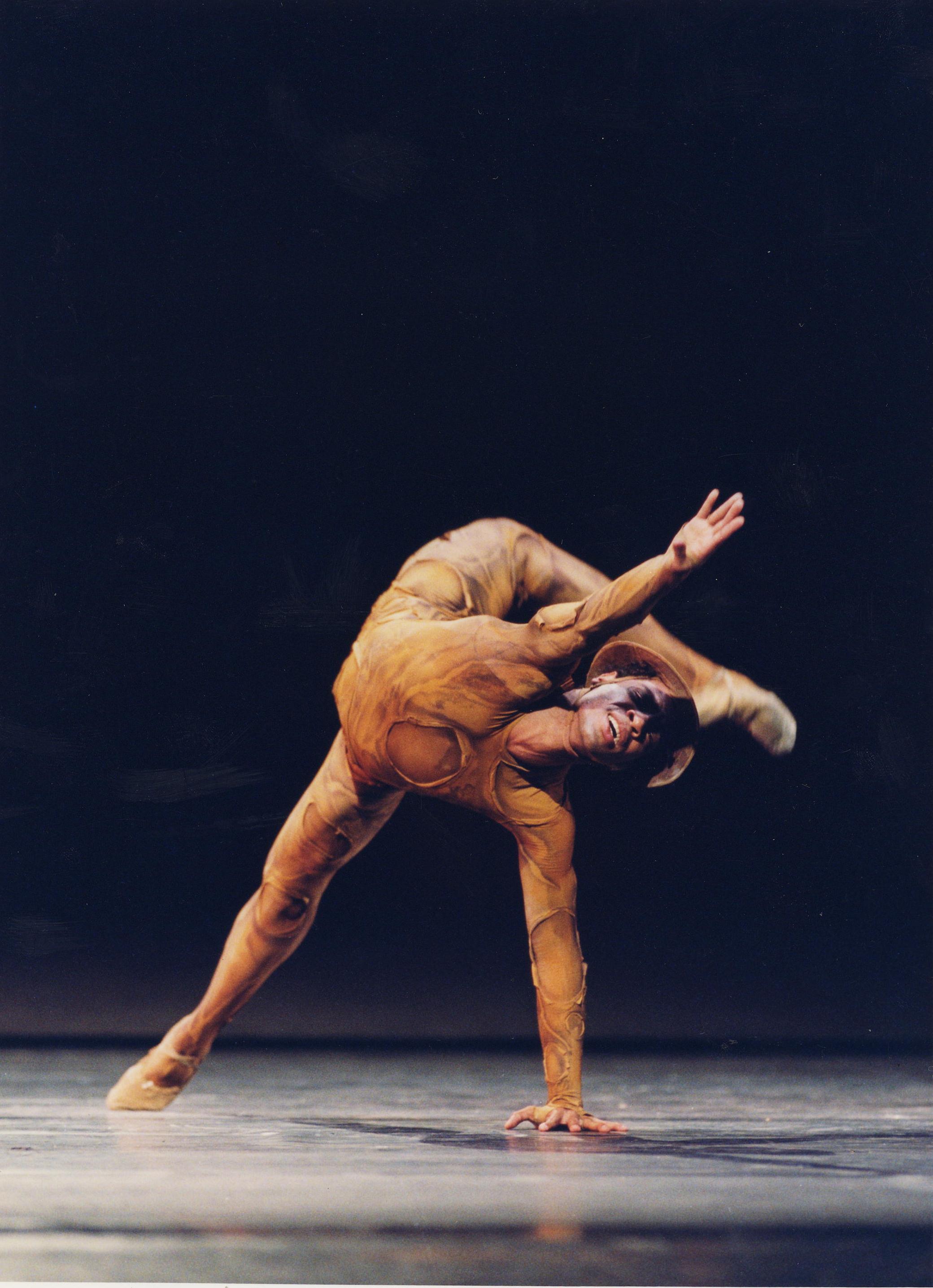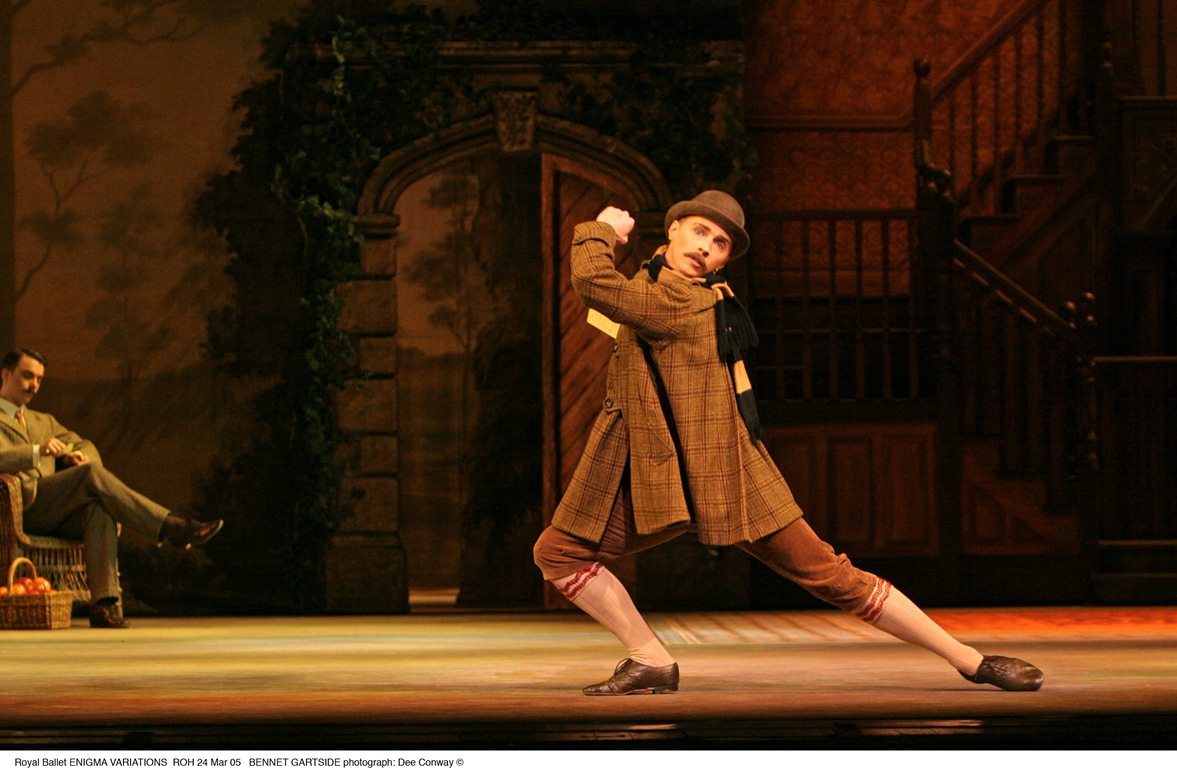Royal Ballet, Asphodel Meadows/Enigma Variations/Gloria | reviews, news & interviews
Royal Ballet, Asphodel Meadows/Enigma Variations/Gloria
Royal Ballet, Asphodel Meadows/Enigma Variations/Gloria
Love, death and discretion: a very English evening

“Over the top” is a curious expression. Originating in World War One, to mean going over the edge of a trench and into battle, it has altered by degrees to mean anything extravagant or outrageous. And Gloria, which is arguably Kenneth MacMillan’s masterpiece, has both the literal and figurative meanings of going over the top layered upon each other.
The spare, terse set by Andy Klunder, a skeletal structure in front of a small slope, in sere, dying yellows and dried-blood reds, gives us our no-man’s-land, where soldiers (the Tommy’s tin hat is the only indication of occupation or period) appear, one by one from the trench at the back of the stage. In among them dart and flicker grey-skirted, grey-faced women, angels of death, both comforting the men and leading them to their deaths. It is MacMillan’s triumph to have seen in Poulenc’s odd, quirky, flickering brightness the horror and tragedy of a generation as these avatars of death go busily about their business.
 Carlos Acosta (pictured right, photo: Dee Conway) and Thiago Soares were the two soldiers, with Sarah Lamb their angel. Soares’s rusty, bloodied shapes were compelling; Acosta only slightly less so in that his body falls so naturally into a pure classical line that he sometimes failed to achieve MacMillan’s tormented poses.
Carlos Acosta (pictured right, photo: Dee Conway) and Thiago Soares were the two soldiers, with Sarah Lamb their angel. Soares’s rusty, bloodied shapes were compelling; Acosta only slightly less so in that his body falls so naturally into a pure classical line that he sometimes failed to achieve MacMillan’s tormented poses.
Edward Watson has, in the past, used his hyper-extended arms to create a compelling picture in this piece, but in this programme was instead a more restrained, and touching, Arthur Troyte Griffith in Ashton’s Enigma Variations, the centrepiece of the evening. Enigma is a problem piece, with superficially only Edwardian fustiness, and nothing to say to a modern audience.
But this would be to underestimate both it and Ashton. Today, in a culture that welcomes emotional incontinence, there is something pleasurable in an act of withholding, of discretion. The core of the piece is in the pas de trois between the composer Edward Elgar (Christopher Saunders), his friend, Jaeger (Bennet Gartside) and Elgar’s wife (Christina Arestis). Ashton pared away the steps until only vestigial gestures remained, indications of a yearning and desire for which his characters have no words. Yet it is in their inability to express their emotions that the strength of the piece lies, as Ashton mirrors the way the lush Romanticism of Elgar’s orchestration contrasts with its austere structure, a series of formal variations.
 In the trio’s single raised-arm gesture, as the crescendo rises, they encompass love and loss, loneliness and friendship – loneliness in friendship, a desire for what isn’t there matched by gratitude for what is. These are complex, and very grown-up emotions. It is not easy, always, to discern them under Julia Trevelyan Oman’s now dusty-feeling sets, but, in particular, Gartside (pictured left, as William Meath Baker, in the same ballet, photo: Dee Conway) and Arestis have the ability to say much with the bare minimum. A very English talent.
In the trio’s single raised-arm gesture, as the crescendo rises, they encompass love and loss, loneliness and friendship – loneliness in friendship, a desire for what isn’t there matched by gratitude for what is. These are complex, and very grown-up emotions. It is not easy, always, to discern them under Julia Trevelyan Oman’s now dusty-feeling sets, but, in particular, Gartside (pictured left, as William Meath Baker, in the same ballet, photo: Dee Conway) and Arestis have the ability to say much with the bare minimum. A very English talent.
Neither of these pieces are easy to programme with their harrowing and glancing emotionalism. Liam Scarlett’s Asphodel Meadows seems to have been selected because of choice of music (Poulenc’s Double Piano Concerto, making the evening a Poulenc sandwich) and its reference, too, to the dead. The Plains of Asphodel were, in the Odyssey, the place in Hades for those dead who did not reach the Elysian Fields, left there to repeat endlessly after death their lives as they had been lived above ground. Scarlett, only 24 when this piece premiered last year, has created an astonishingly efficient and workmanlike piece for three couples, whose pas de deux emotionally recapitulate their above-ground situations. The puckish, darting music is, in particular, well suited to Marianela Nuñez (main photo above), fleet and sleek, and Tamara Rojo, who purrs through her section like the well-oiled Rolls-Royce she is.
Yet this work, despite its title and its elegant black-and-white set, immaculately conceived by John MacFarlane, is really a piece of Neo-Classical abstraction. Emotions have little sway here, and there is certainly none of the pity and terror of Gloria. There, in the great culminating pas de trois, the two soldiers and death herself point accusingly at us, the audience. It is our fault that they are dying. And then the accusation is over. MacMillan makes the moment more terrible for being so brief. It is done, and the men walk stoically off, each one turning and looking back, back at life, back at us, and then resuming his way, to his duty, to his death.
- in repertory at the Royal Opera House until 30 November
Watch an extract from Gloria
Share this article
Add comment
The future of Arts Journalism
You can stop theartsdesk.com closing!
We urgently need financing to survive. Our fundraising drive has thus far raised £49,000 but we need to reach £100,000 or we will be forced to close. Please contribute here: https://gofund.me/c3f6033d
And if you can forward this information to anyone who might assist, we’d be grateful.

Subscribe to theartsdesk.com
Thank you for continuing to read our work on theartsdesk.com. For unlimited access to every article in its entirety, including our archive of more than 15,000 pieces, we're asking for £5 per month or £40 per year. We feel it's a very good deal, and hope you do too.
To take a subscription now simply click here.
And if you're looking for that extra gift for a friend or family member, why not treat them to a theartsdesk.com gift subscription?
more Dance
 'We are bowled over!' Thank you for your messages of love and support
Much-appreciated words of commendation from readers and the cultural community
'We are bowled over!' Thank you for your messages of love and support
Much-appreciated words of commendation from readers and the cultural community
 R:Evolution, English National Ballet, Sadler's Wells review - a vibrant survey of ballet in four acts
ENB set the bar high with this mixed bill, but they meet its challenges thrillingly
R:Evolution, English National Ballet, Sadler's Wells review - a vibrant survey of ballet in four acts
ENB set the bar high with this mixed bill, but they meet its challenges thrillingly
 Like Water for Chocolate, Royal Ballet review - splendid dancing and sets, but there's too much plot
Christopher Wheeldon's version looks great but is too muddling to connect with fully
Like Water for Chocolate, Royal Ballet review - splendid dancing and sets, but there's too much plot
Christopher Wheeldon's version looks great but is too muddling to connect with fully
 iD-Reloaded, Cirque Éloize, Marlowe Theatre, Canterbury review - attitude, energy and invention
A riotous blend of urban dance music, hip hop and contemporary circus
iD-Reloaded, Cirque Éloize, Marlowe Theatre, Canterbury review - attitude, energy and invention
A riotous blend of urban dance music, hip hop and contemporary circus
 How to be a Dancer in 72,000 Easy Lessons, Teaċ Daṁsa review - a riveting account of a life in dance
Michael Keegan-Dolan's unique hybrid of physical theatre and comic monologue
How to be a Dancer in 72,000 Easy Lessons, Teaċ Daṁsa review - a riveting account of a life in dance
Michael Keegan-Dolan's unique hybrid of physical theatre and comic monologue
 A Single Man, Linbury Theatre review - an anatomy of melancholy, with breaks in the clouds
Ed Watson and Jonathan Goddard are extraordinary in Jonathan Watkins' dance theatre adaptation of Isherwood's novel
A Single Man, Linbury Theatre review - an anatomy of melancholy, with breaks in the clouds
Ed Watson and Jonathan Goddard are extraordinary in Jonathan Watkins' dance theatre adaptation of Isherwood's novel
 Peaky Blinders: The Redemption of Thomas Shelby, Rambert, Sadler's Wells review - exciting dancing, if you can see it
Six TV series reduced to 100 minutes' dance time doesn't quite compute
Peaky Blinders: The Redemption of Thomas Shelby, Rambert, Sadler's Wells review - exciting dancing, if you can see it
Six TV series reduced to 100 minutes' dance time doesn't quite compute
 Giselle, National Ballet of Japan review - return of a classic, refreshed and impeccably danced
First visit by Miyako Yoshida's company leaves you wanting more
Giselle, National Ballet of Japan review - return of a classic, refreshed and impeccably danced
First visit by Miyako Yoshida's company leaves you wanting more
 Quadrophenia, Sadler's Wells review - missed opportunity to give new stage life to a Who classic
The brilliant cast need a tighter score and a stronger narrative
Quadrophenia, Sadler's Wells review - missed opportunity to give new stage life to a Who classic
The brilliant cast need a tighter score and a stronger narrative
 The Midnight Bell, Sadler's Wells review - a first reprise for one of Matthew Bourne's most compelling shows to date
The after-hours lives of the sad and lonely are drawn with compassion, originality and skill
The Midnight Bell, Sadler's Wells review - a first reprise for one of Matthew Bourne's most compelling shows to date
The after-hours lives of the sad and lonely are drawn with compassion, originality and skill
 Ballet to Broadway: Wheeldon Works, Royal Ballet review - the impressive range and reach of Christopher Wheeldon's craft
The title says it: as dancemaker, as creative magnet, the man clearly works his socks off
Ballet to Broadway: Wheeldon Works, Royal Ballet review - the impressive range and reach of Christopher Wheeldon's craft
The title says it: as dancemaker, as creative magnet, the man clearly works his socks off
 The Forsythe Programme, English National Ballet review - brains, beauty and bravura
Once again the veteran choreographer and maverick William Forsythe raises ENB's game
The Forsythe Programme, English National Ballet review - brains, beauty and bravura
Once again the veteran choreographer and maverick William Forsythe raises ENB's game

Comments
After years of exhaustive
Oh, go AWAY, Mr Padgett! You
An excellent summation but
I really enjoyed reading your